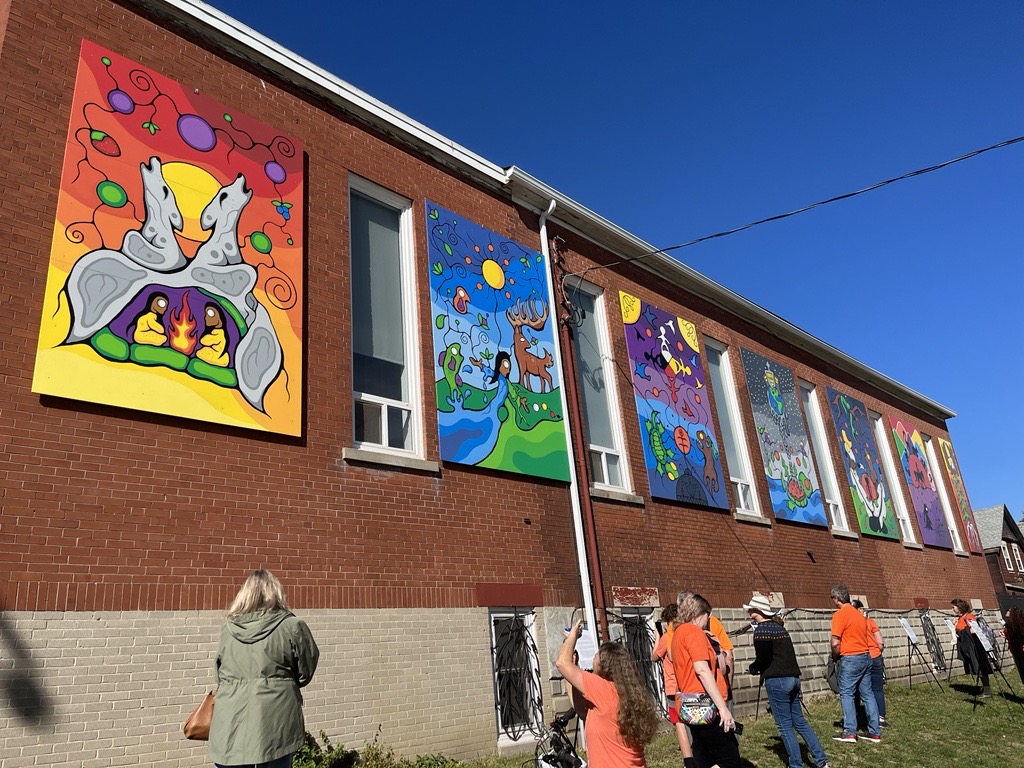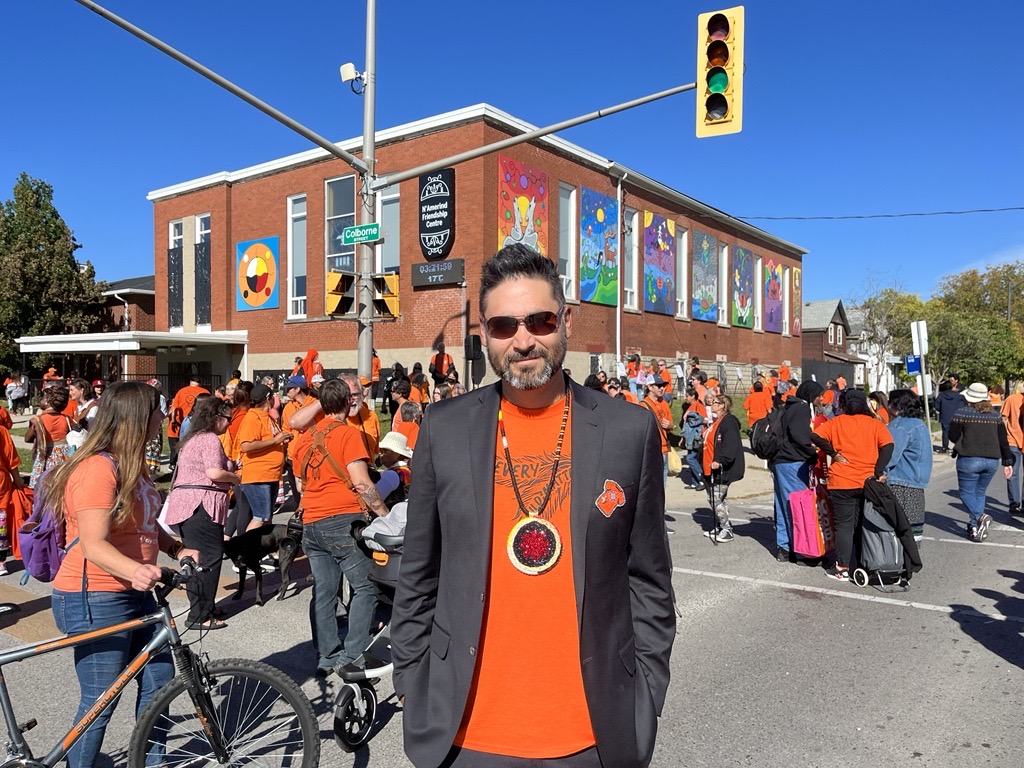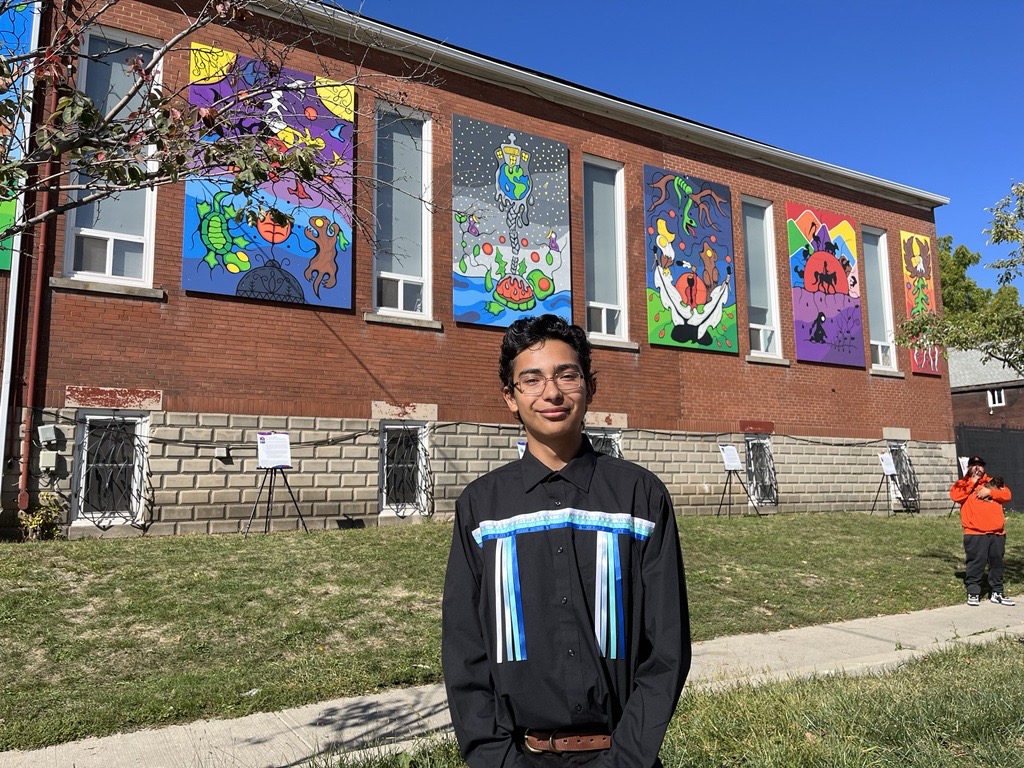A new mural has been unveiled outside of the N’Amerind Friendship Centre that intends to honour survivors of Canada’s residential schools system and remember the children who died.

Presented in part by the Friendship Centre, London, Ont., city officials and the London Arts Council, the two-story, seven-panel mural is the result of a collaboration between Ojibwe educator and artist Mike Cywink, residential school survivors and Indigenous youth artists.
The unveiling was held on Friday afternoon to mark the second annual National Day for Truth and Reconciliation.
The artwork is titled We Are Still Here, but each panel carries its own name and meaning.
The seven panels, as seen from left to right when looking at the southern wall of N’Amerind Friendship Centre from Horton Street, are titled Story Tellers, Where We Were, Our Creation Stories, 215, Breaking The Cycle, Now and Great Tree of Peace.
Friday’s unveiling also included speeches, prayer, Jingle Dress dancing, songs and a gathering of at least 200 people at corner of Colborne and Horton streets.
- Life in the forest: How Stanley Park’s longest resident survived a changing landscape
- Bird flu risk to humans an ‘enormous concern,’ WHO says. Here’s what to know
- Mental health support still lacking 4 years after mass shooting: Nova Scotia mayor
- Buzz kill? Gen Z less interested in coffee than older Canadians, survey shows
It was a day filled with mixed emotions for Cywink, the lead artist behind We Are Still Here.
“I know we’re here celebrating the good things and the work and stuff, but it was still a heavy morning for me. I think about the kids, the children, the ones who never made it home from residential schools,” Cywink said.
Cywink, who is from the Whitefish River First Nation near Manitoulin Island, describes his art as storytelling and says speaking directly to residential school survivors was especially important for the narrative behind We Are Still Here.
“I’m telling a story that’s partially mine – I never attended residential schools, but a lot of people I care about and love have… I think that consultation (with survivors) was pretty important in terms of me wanting to make sure that I tell the story correctly,” Cywink added.
“I think there’s a lot of responsibility that goes with public artwork, especially Indigenous artwork, because I feel like I’m partly representing a big chunk of the Indigenous community, so that was why making sure I tell the story correctly was such an important factor for me and then just making sure we did a good job.”
Sir Frederick Nicholas, 16, is one of the three Indigenous youth artists who were selected to help out with We Are Still Here, an opportunity that the young artist considers a great honour.
“I didn’t quite know the scale of the project and how big it would be in the community, I just knew I’m making paintings, they’re going to go on the side of the building, everybody’s going to see them, but being here today, I start to realize just how much this means to everybody,” Nicholas said.
Nicholas, who is a Turtle Clan member from Oneida Six Nations of the Grand River, describes Cywink as someone he looks up to and hopes to work with again in the future.
As for the work, he said he felt a lot of pressure leading up to the finished product, but is proud now that all is said and done.
“Now that they’re up, we know for a fact that we got it right.”
During Friday’s unveiling of the mural, Nicholas wore a shirt modelled after another one worn by his late great-grandfather. The symbolic garment was made by his mom within a single day, a feat Nicholas describes as “not easy to do.”
“He wore a shirt just like this, he was buried in it. When I put it on, I feel like I just got that much more connected to him … I have his name and now I have one of his shirts,” Nicholas said, adding that this connection was echoed in his contributions to We Are Still Here.
“Not only did I leave a piece of myself in these pieces of art, I feel like I also left a piece of him in there too, a way for him to be remembered.”
Both Cywink and Nicholas hope the artwork will inspire observers to learn more about Indigenous history and the history of Canada’s residential school system.










Comments